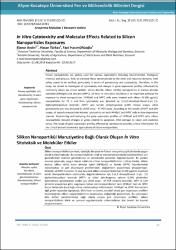In vitro cytotoxicity and molecular effects related to silicon nanoparticles exposures
Özet
Silicon nanoparticles are widely used for various applications including environmental, biological,
chemical and physical. And, to translate these nanomaterials to the clinic and industrial domains, their
safety needs to be verified, particularly in terms of genotoxicity and cytotoxicity. Therefore, in this
study, we aimed to investigate of cytotoxicity and changes in gene expression profiles influenced by
commonly silicon (as silicon carbide, silicon dioxide, silicon nitride) nanoparticles in human alveolar
epithelial (HPAEpiC) and pharynx (HPPC) cell lines in vitro since inhalation is an important pathway for
exposure to these nanoparticles. HPAEpiC and HPPC cells were treated with silicon (0-100 µg/mL),
nanoparticles for 72 h, and then cytotoxicity was detected by, [3-(4,5-dimethyl-thiazol-2-yl) 2,5-
diphenyltetrazolium bromide] (MTT) and lactate dehydrogenase (LDH) release assays, while
genotoxicity was also analyzed by cDNA array - RT-PCR assay. According to the results of MTT and LDH
assays, all tested nanoparticles induced cytotoxicity on both HPAEpiC and HPPC cells in dose-dependent
manner. Determining and analyzing the gene expression profiles of HPAEpiC and HPPC cells, silicon
nanoparticles showed changes in genes related to apoptosis, DNA damage or repair and oxidative
stress. This study of gene expression profiles affected by nanotoxicity provides critical information for
the clinical and environmental applications of silicon nanoparticles. Silikon nanopartikülleri çevresel, biyolojik, kimyasal ve fiziksel amaçlarla çeşitli alanlarda yaygın
olarak kullanılmaktadır. Bu nanopartiküllerin klinik ve endüstriyel alanlarda kullanılabilmesi için
güvenilirlikleri özellikle genotoksisite ve sitotoksisite açısından doğrulanmalıdır. Bu yüzden
mevcut çalışmada, yaygın olarak kullanılan silikon nanopartiküllerinin ( silikon karbid, silikon
dioksit, silikon nitrit) insan alveolar epitel (HPAEpiC) ve farinks (HPPC) hücrelerindeki
sitotoksisitesi ve gen ekspresyon profillerindeki değişimlerin araştırılması amaçlanmıştır.
HPAEpiC ve HPPC hücreleri 72 saat boyunca silikon nanopartikülleriyle (0-100 µg/mL) muamele
edildi. Nanopartiküllerin sitotoksisite değerlendirmeleri için 3-(4,5 dimetylthiazol -2-yl) - 2,5
diphenltetrazolium bromide (MTT) ve laktat dehidrogenaz salınım (LDH) yöntemleri
kullanılırken; genotoksisite analizi için cDNA array - RT-PCR yöntemi kullanıldı. MTT ve LDH
yöntemi sonuçlarına göre, uygulanan bütün test nanopartikülleri hem HPAEpiC hem de HPPC
hücre hatlarında doza bağlı olarak sitotoksisiteyi indüklemiştir. HPAEpiC ve HPPC hücrelerinin
ilgili genler açısından (apoptozis, DNA fasarı ve tamiri, oksidatif stres) gen ekspresyon profilleri
incelendiğinde silikon naopartiküllerinin ekspresyonu değiştirdiği gözlenmiştir. Bu çalışmadan
elde edilen nanotoksisiteye bağlı olarak oluşan gen ekspresyon profilleri, silikon
nanopartiküllerin klinik ve çevresel uygulamalarda kullanılabilmesi için önemli bir kaynak
oluşturmaktadır.
Kaynak
Afyon Kocatepe Üniversitesi, Fen ve Mühendislik Bilimleri DergisiCilt
17Sayı
1Bağlantı
http://fenbildergi.aku.edu.tr/wp-content/uploads/2017/04/011002-10-17.pdf2149-3367
http://hdl.handle.net/11630/4580
Koleksiyonlar
- Cilt 17 : Sayı 1 [41]



















